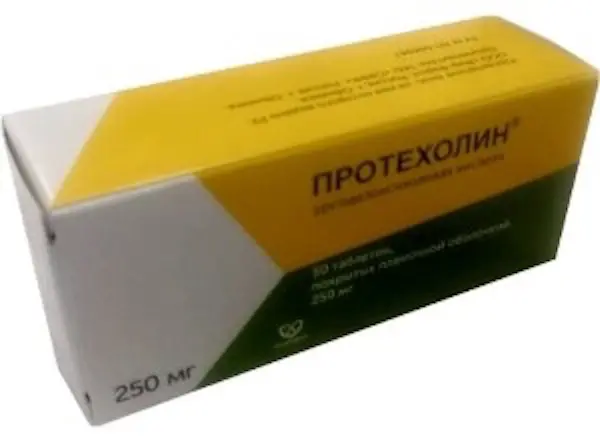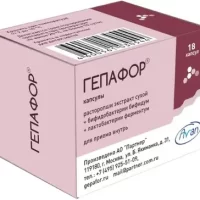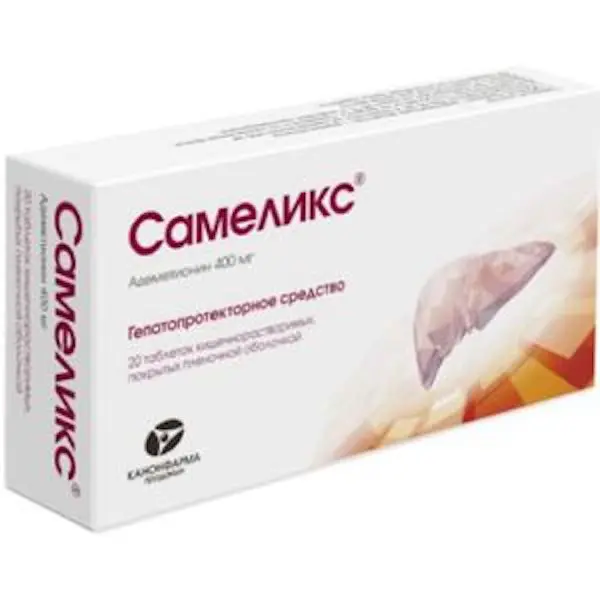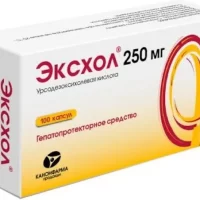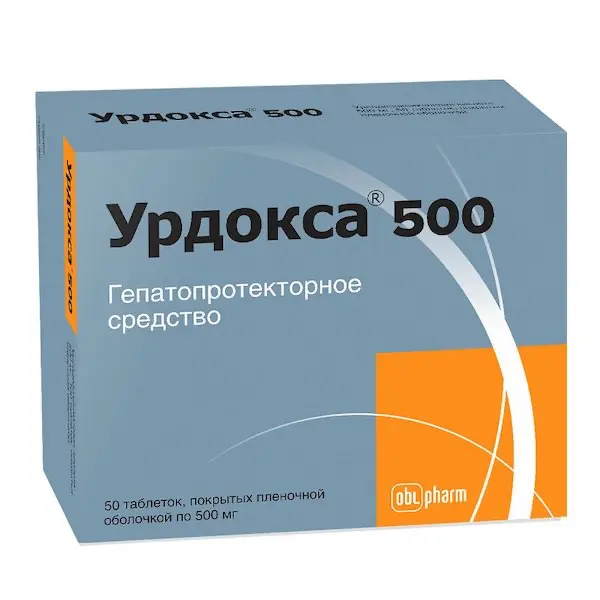Description
Proteholin Pharmacodynamics
Hepatoprotective drug, also has choleretic, cholestolytic, hypolipidemic, hypoglycemic and immunostimulatory actions.
Having high polar properties, ursodeoxycholic acid (UDCA) forms non-toxic mixed micelles with apolar toxic bile acids, which reduces the damaging effect of gastric refluxate on cell membranes in biliary reflux gastritis and reflux esophagitis. In addition, UDCA forms double molecules capable of incorporating into cell membranes (hepatocytes, cholangiocytes, GIT epitheliocytes) and stabilizing them, as well as reducing membrane susceptibility to the action of cytotoxic micelles.
By reducing the concentration of bile acids toxic to hepatocytes and stimulating bicarbonate-rich choleresis, UDCA helps eliminate intrahepatic cholestasis. By reducing absorption of cholesterol in intestine, as well as suppressing its synthesis in liver and secretion into bile, it decreases its concentration in bile; by forming liquid crystals with cholesterol in bile, it increases its solubility; reduces lithogenic index of bile. The result of the complex action of UDCA is the dissolution of cholesterol gallstones and the prevention of the formation of new concrements.
Causes increase in gastric and pancreatic secretion, increases lipase activity. Has a hypoglycemic effect.
It has immunomodulatory effect, affects immune reactions in the liver: it decreases the expression of HLA-1 antigen on hepatocyte membranes and HLA-2 on cholangiocytes; it normalizes the natural killer activity of lymphocytes, affects the number of T-lymphocytes, interleukin-2 formation, decreases the number of eosinophils. Significantly delays the progression of fibrosis in patients with primary biliary cirrhosis, cystic fibrosis, and alcoholic steatohepatitis; reduces the risk of varices development. UDCA slows the processes of premature aging and cell death (hepatocytes, cholangiocytes, etc.).
Pediatric population.
Cystic fibrosis (cystic fibrosis)
There is a long history (up to 10 years or more) of treatment with UDCA for children with hepatobiliary disease associated with cystic fibrosis (CFAHD). There is evidence that UDCA therapy is able to reduce the proliferation of bile ducts, slow down the development of lesions revealed by histological examination, at the beginning of therapy at early stages of CFAHD it promotes the reverse development of changes in hepatobiliary system. In order to optimize the efficiency of treatment, UDCA therapy should be started as early as possible after the diagnosis of CFAHD is made.
Indications
– Dissolution of cholesterol gallstones;
– Chronic hepatitis of different genesis;
– alcoholic liver disease;
– non-alcoholic steatohepatitis;
– Primary biliary cirrhosis in the absence of signs of decompensation (symptomatic treatment);
– Primary sclerosing cholangitis;
– cystic fibrosis (as part of complex therapy);
– biliary dyskinesia;
– biliary reflux gastritis.
Contraindications
– Hypersensitivity to drug components or other bile acids;
– X-ray-positive (high calcium) gallstones;
– impaired gallbladder contractility (non-functioning gallbladder);
– biliary-gastric fistula;
– acute inflammatory diseases of the gallbladder, bile ducts and intestines; acute cholecystitis; acute cholangitis; empyema of the gallbladder;
– decompensated liver cirrhosis;
– Severe hepatic and/or renal insufficiency;
– biliary tract occlusion (occlusion of common bile or bladder ducts);
– Frequent episodes of biliary colic;
– Children under 3 years of age (for this dosage form).
Pediatric population.
Unsuccessfully performed portoenterostomy or cases of failure to restore normal bile flow in children with biliary tract atresia.
In children under 3 years of age as well as in patients who have difficulty swallowing tablets, it is recommended to use UDCA preparations in the form of suspension.
Dosage and administration
- Tablets should be taken regularly without chewing, with plenty of water. Patients who cannot swallow tablets or with body weight less than 47 kg are recommended to prescribe UDCA in suspension form.
- Dissolution of cholesterol gallstones
- The recommended dose is 10 mg of ursodeoxycholic acid per 1 kg of body weight per day, which corresponds to:
- Body weight Daily dose
- Up to 60 kg 500 mg
- 61-80 kg 750 mg
- 81-100 kg 1000 mg
- More than 100 kg 1250 mg
- It usually takes 6 to 24 months for gallstones to dissolve. If after 12 months of treatment the size of stones does not decrease, treatment should be discontinued.
- The effectiveness of treatment should be evaluated every 6 months by ultrasound or radiography. In an interim follow-up evaluation, it should be assessed whether the stones have calcified since then. If stones have calcified, treatment should be discontinued.
- Treatment of biliary reflux gastritis
- Take 250 mg daily in the evening before going to bed. Duration of treatment: from 10-14 days to 6 months, if necessary – up to 2 years.
- Treatment of primary biliary cirrhosis
- Daily dose depends on body weight and varies from 750 mg to 1750 mg (14 ± 2 mg UDCA per 1 kg of body weight).
- During the first 3 months of treatment, the daily dose should be divided into several doses. After improvement of liver functional parameters it is possible to switch to single daily dose in the evening.
- Body weight (kg) Daily dose (mg/kg) UDCA
- First 3 months Thereafter
- Morning Noon Evening (single dose)
- 47-62 12-16 250 mg 250 mg 750 mg
- 63-78 13-16 250 mg 250 mg 500 mg 1000 mg
- 79-93 13-16 250 mg 500 mg 500 mg 1250 mg
- 94-109 14-16 500 mg 500 mg 1500 mg
- over 110 to 500 mg 500 mg 750 mg 1750 mg
- The use of the drug for the treatment of primary biliary cirrhosis may be continued indefinitely.
- In patients with primary biliary cirrhosis in rare cases at the beginning of treatment clinical symptoms may worsen, for example, itching may increase. In this case, treatment should be continued by taking 250 mg daily, then the dose should be gradually increased (increasing the daily dose weekly by 250 mg) until the recommended dosing regimen is achieved again.
- Symptomatic treatment of chronic hepatitis of different genesis
- Daily dose is 10-15 mg/kg in 2-3 intakes. Duration of treatment – 6-12 months or more.
- Primary sclerosing cholangitis
- The daily dose is 12-15 mg/kg; if necessary, the dose may be increased to 20 mg/kg
- in 2-3 doses. Duration of therapy ranges from 6 months to several years (see sect. “Cautions”).
- Cystic fibrosis (as part of complex therapy).
- Daily dose is 20 mg/kg/day in 2-3 doses; if necessary, the dose may be increased to 30 mg/kg/day.
- Body weight (kg) Daily dose (mg/kg body weight) UDCA
- Morning Noon Evening
- 20-29 17-25 250 mg
- 30-39 19-25 250 mg 250 mg
- 40-49 20-25 250 mg 250 mg 500 mg
- 50-59 21-25 250 mg 500 mg
- 60-69 22-25 500 mg 500 mg
- 70-79 22-25 500 mg 500 mg 750 mg
- 80-89 22-25 500 mg 750 mg 750 mg
- 90-99 23-25 750 mg 750 mg 750 mg
- 100-109 23-25 750 mg 750 mg 1000 mg
- >110 750 mg 1000 mg 1000 mg
- Non-alcoholic steatohepatitis, alcoholic liver disease
- The average daily dose is 10-15 mg/kg in 2-3 doses. The duration of therapy is from 6-12 months or more.
- Biliary dyskinesia
- Average daily dose is 10 mg/kg in 2 intakes during 2 weeks to 2 months. If necessary, it is recommended to repeat the treatment course.

